14.7.1: Calcite Group Minerals
- Page ID
- 18672
Calcite CaCO3
Origin of Name
From the Latin word calx, meaning “burnt lime.”
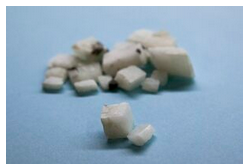
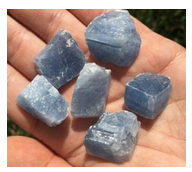
Hand Specimen Identification
Calcite is identified by its hardness of 3, rhombohedral cleavage, and effervescence in cold dilute HCl. It may be confused with dolomite or aragonite. Dolomite however, does not react as readily to HCl, and aragonite is orthorhombic. Calcite can also be distinguished from dolomite using a red alizarin stain that turns calcite pinkish.
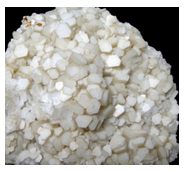
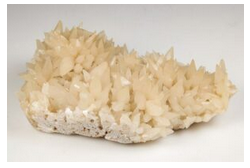
Some calcite specimens contain euhedral crystals, but many are rhombohedral cleavage fragments like those in Figures 14.361 and 14.362. The photo in Figure 14.361 shows calcite with its most common whitish color. The photo in Figure 14.362 shows (less common) blue calcite cleavage fragments. Other colors too, are possible.
When euhedral, calcite may form crystal clusters such as those seen in Figures 14.363 and 14.364. Note that the crystals in these two photos have significantly different shapes. Calcite commonly twins; Figure 7.40 (Chapter 7) shows one example.
Physical Properties
| hardness | 3 |
| specific gravity | 2.71 |
| cleavage/fracture | perfect rhombohedral {101}/conchoidal |
| luster/transparency | vitreous/transparent to translucent |
| color | colorless to white; may also be tinted many other light colors when impure |
| streak | white |
Properties in Thin Section
Calcite is colorless in thin section and has extremely high birefringence, resulting in pale, washed out, or “pearl” white interference colors. Polysynthetic twinning is nearly always visible. This mineral shows high variable relief upon stage rotation. In thin section, calcite may be confused with other hexagonal carbonates. Orthorhombic carbonates, however, have parallel extinction and are biaxial. Calcite is uniaxial (-), ω = 1.658, ε = 1.486, δ = 0.172.
Crystallography
Calcite forms trigonal crystals. a = 4.99, c = 17.04, Z = 6; space group \(R\overline{3}\dfrac{2}{c}\); point group \(\overline{3}\dfrac{2}{m}\).
Habit
Calcite has many habits. Coarse crystals are highly variable. The most common forms are hexagonal prisms with simple to complex terminations, scalenohedra (often with combinations of other forms), rhombohedra (either acute or flattened), and tabs with well-developed basal faces. Polysynthetic twinning is common but usually requires a microscope to detect. Besides forming coarse crystals, calcite may be a fine-grained massive rock-forming mineral, it may make up fine to coarse granular aggregates, and it may precipitate as nodules or crusts or in speleothems.
Structure and Composition
Calcite is isostructural with other members of the calcite group. In calcite, Ca2+ ions alternate with (CO3)2- groups in a three-dimensional array. The atomic arrangement is related to the structure of cubic salts, such as halite or periclase, but is not cubic because the structure has been squashed along the equivalent of a main diagonal of the cube. The shortened direction is the c-axis in calcite; planar (CO3)2- groups are perpendicular to c, giving the structure a 3-fold axis of symmetry in that direction only. Mg, Fe, Mn, Zn, and a number of others may substitute for some of the Ca; except for Mn, most solid solutions are quite limited.
Occurrence and Associations
Calcite is a common and widespread mineral. It is an essential and major mineral in limestones and marbles, occurs in cave deposits, and occurs as a vein mineral with other carbonates, sulfides, barite, fluorite, and quartz. Calcite also occurs in some rare carbonate-rich igneous rocks and is a common cement in some sandstones. Calcite is an accessory mineral in rocks of many sorts. It is also a common weathering product. Organic calcite is found in shells and skeletal material.
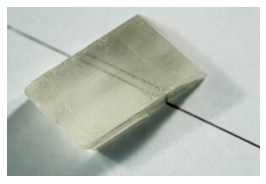
Varieties
Several different varieties of calcite, having special properties, have their own name. Iceland spar, for example, is the name given to clear calcite, usually in rhombohedral cleavage fragments. Iceland spar is one of a very few mineral varieties that cause double refraction that can be seen without the aid of a petrographic microscope. An image behind a crystal appears double when viewed through the crystal. Figure 14.365 is a photo of Iceland spar that displays this property.

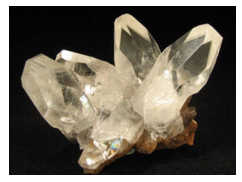
Related Minerals
Calcite has two polymorphs, aragonite, and vaterite. It is isostructural with magnesite, MgCO3; siderite, FeCO3; sphaerocobaltite, CoCO3; smithsonite, ZnCO3; nitratite, NaNO3; dolomite, CaMg(CO3)2; and gaspeite, (Ni,Mg,Fe)(CO3). Calcite and rhodochrosite form extensive solid solutions at room temperature and a complete solid solution above about 550 ºC (1,020ºF). Calcite forms limited solid solutions with ankerite, CaFe(CO3)2; dolomite, CaMg(CO3)2; and kutnohorite, CaMn(CO3)2, at all temperatures.
Magnesite MgCO3
Origin of Name
The name refers to its composition.
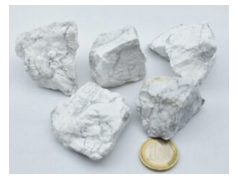
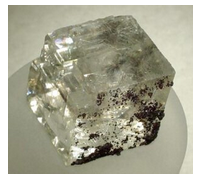
Hand Specimen Identification
Massive forms of magnesite may be chalky or porcelain-like, such as the specimens seen in Figure 14.368. When massive and fine-grained like the samples shown in this photo, mineral identification may be uncertain.
Magnesite may be confused with other soft white minerals, especially other carbonates. It is occasionally confused with chert but has inferior hardness. Coarse crystals of magnesite are rhomb-shaped and display rhombohedral cleavage (Figure 14.369) – identifying it as a carbonate – but it may be difficult to distinguish from other rhombohedral carbonates. However, magnesite is denser than dolomite and does not react to cold HCl like calcite, which helps with identification.
Physical Properties
| hardness | 3.5 to 5 |
| specific gravity | 3.00 |
| cleavage/fracture | perfect rhombohedral {101}/conchoidal |
| luster/transparency | porcelainous/transparent to translucent |
| color | white, gray, brown, or yellow |
| streak | white |
Properties in Thin Section
Magnesite is similar to calcite in thin section but has higher index of refraction (see calcite optics). Uniaxial (-), ω = 1.700, ε = 1.509, δ = 0.191.
Crystallography
Magnesite forms trigonal crystals. a = 4.59, c = 14.87, Z = 6; space group \(R\overline{3}\dfrac{2}{c}\); point group \(\overline{3}\dfrac{2}{m}\).
Habit
Coarse crystals are rare; magnesite is usually massive, granular, fibrous, or earthy.
Structure and Composition
Magnesite is isostructural with calcite and other members of the calcite group (see calcite structure, above). Large amounts of Fe commonly substitute for Mg. Mn, Ca, Ni, and Zn may also be present in small amounts.
Occurrence and Associations
Magnesite is most common in veins or masses as an alteration product of mafic minerals. It also occurs in some Mg-rich schists and as a primary mineral in some rare chemical sediments. It is sometimes found as a replacement for calcite or dolomite in limestone.
Varieties
Breunnerite is a Fe-rich variety of magnesite; hoshiite is an Ni-rich variety.
Related Minerals
Magnesite forms complete solid solutions with siderite, FeCO3, and with gaspeite, (Ni,Mg,Fe)CO3. Other related minerals include hydromagnesite, Mg5(CO3)4(OH)2•4H2O.
Siderite FeCO3
Origin of Name
From the Greek word sideros, meaning “iron.”
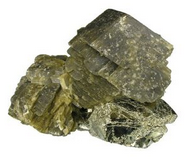
Hand Specimen Identification
Coarse siderite crystals have the same rhombohedral shape and cleavage as other rhombohedral carbonates (Figure 14.370). Siderite can be distinguished from the other carbonates by its high specific gravity and brownish-green color. It effervesces slightly in warm HCl. It may be confused with sphalerite (which can have a similar brown color and the same hardness).
Physical Properties
| hardness | 3.5 to 4 |
| specific gravity | 3.96 |
| cleavage/fracture | perfect rhombohedral {101}/subconchoidal |
| luster/transparency | vitreous/translucent |
| color | various shades of brown or brown-green are typical |
| streak | white |
Properties in Thin Section
Siderite is colorless to pale yellow-brown in thin section. It appears similar to calcite and other carbonates, but the other carbonates have a lower index of refraction and lack color. Uniaxial (-), ω = 1.875, ε = 1.633, δ = 0.242.
Crystallography
Siderite forms trigonal crystals. a = 4.72, c = 15.46, Z = 6; space group \(R\overline{3}\dfrac{2}{c}\); point group \(\overline{3}\dfrac{2}{m}\).
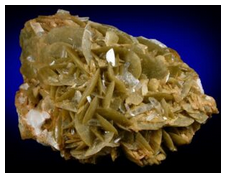
Habit
Siderite crystals are typically rhombohedra, often with curved faces. Fine- to coarse-grained aggregates, such as the reticulated aggregate seen in Figure 14.371, are common. Aggregates may also be colloform, globular, botryoidal, fibrous, or earthy.
Structure and Composition
Siderite is isostructural with calcite and other members of the calcite group (see calcite structure). Mn and Mg often substitute for Fe. Small amounts of Ca, Zn, and Co may be present.
Occurrence and Associations
Siderite is a relatively common mineral found in veins with galena, pyrite, chalcopyrite, and tetrahedrite; as a rock-forming mineral associated with limestone, clay, shale, coal or ironstone; as a replacement mineral in limestone; and less commonly in metamorphic rocks.
Related Minerals
Siderite is isostructural with calcite and a number of other minerals (see calcite related minerals, above). It forms complete solid solutions with rhodochrosite, MnCO3, and magnesite, MgCO3.
Rhodochrosite MnCO3
Origin of Name
From the Greek words meaning “rose” and “color,” referring to its rose-pink color.
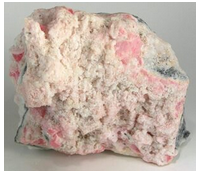
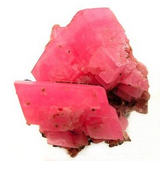
Hand Specimen Identification
Pink color and rhombohedral carbonate morphology identify rhodochrosite. The two photos here show examples from Silverton, Colorado. Some rhodochrosite specimens have a light-pink to beige color, like the one in Figure 14.372. Others may be deeply colored, like the rhombs in Figure 14.373. Figure 7.30 is a photo of pink rhodochrosite rhombs with quartz.
Its rhomb-shaped crystals help identify this mineral but, if crystal morphology is uncertain, rhodochrosite may be mistaken for rhodonite (also a pink Mn-mineral). Rhodonite, however, is significantly harder (H = 5.5 to 6, compared with rhodochrosite’s 3.5 to 4). Rhodochrosite also effervesces slightly with cold dilute hydrochloric acid; rhodonite does not effervesce at all.
Physical Properties
| hardness | 3.5 to 4 |
| specific gravity | 3.70 |
| cleavage/fracture | perfect rhombohedral {101}/uneven |
| luster/transparency | vitreous, pearly/transparent to translucent |
| color | rose-red, light pink to dark brown |
| streak | white |
Properties in Thin Section
Rhodochrosite is colorless or pale pink in thin section, has extremely high birefringence, and three perfect cleavage directions. It may be confused with calcite and other carbonates. Uniaxial (-), ω = 1.816, ε = 1.597, δ = 0.219.
Crystallography
Rhodochrosite belongs to the trigonal system. a = 4.74, c = 15.51, Z = 6; space group \(R\overline{3}\dfrac{2}{c}\); point group \(\overline{3}\dfrac{2}{m}\).
Habit
Rhodochrosite forms rare rhombohedral crystals. It is usually fine-grained and massive, sometimes granular, botryoidal, columnar, or crusty.
Structure and Composition
Rhodochrosite is isostructural with calcite and other members of the calcite group (see calcite structure, above). Zn commonly replaces some Mn; Ca, Mg, Cd, and Co may be present in limited amounts.
Occurrence and Associations
Rhodochrosite is uncommon. It is found with other manganese minerals in Mn-rich metamorphic rocks, as a primary mineral in sulfide veins and some replacement bodies, and as a secondary mineral in residual deposits.
Related Minerals
Rhodochrosite forms solid solutions with calcite, CaCO3; siderite, FeCO3; and kutnohorite, CaMn(CO3)2.
Smithsonite ZnCO3
Origin of Name
Named after James Smithson (1754–1829), founder of the Smithsonian Institute.
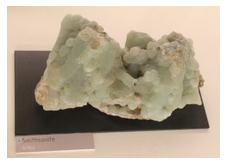
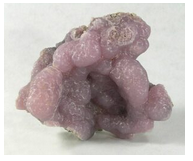
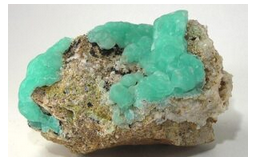
Hand Specimen Identification
Rhombohedral carbonate habit, color (typically light green or purplish), high density, and association with other Zn-minerals identify smithsonite. If not distinctly colored, it may be difficult to tell from other dense carbonates. It is occasionally confused with hemimorphite, another commonly light-green soft mineral. The light-green and lilac colors seen in the first two photos above are typical; the stronger green-turquoise color in Figure 14.376 is less common.
Physical Properties
| hardness | 4 to 4.5 |
| specific gravity | 4.43 |
| cleavage/fracture | perfect rhombohedral {101}/subconchoidal |
| luster/transparency | pearly, vitreous/transparent to translucent |
| color | typically green; also purple, lilac, pink, and other colors |
| streak | white |
Properties in Thin Section
Smithsonite is uniaxial (-), ω = 1.850, ε = 1.625, δ = 0.225.
Crystallography
Smithsonite belongs to the trigonal crystal system. a = 4.61, c = 14.88, Z = 6; space group \(R\overline{3}\dfrac{2}{c}\); point group \(\overline{3}\dfrac{2}{m}\).
Habit
Crystals, when they are euhedral or subhedral, show rhombohedral form and cleavage. More typical smithsonite is massive, colloform, earthy, stalactitic, or forms crusts.
Structure and Composition
Smithsonite is isostructural with calcite and other members of the calcite group (see calcite structure, above). It typically contains substantial amounts of Fe. It may also contain smaller amounts of Ca, Co, Cu, Cd, Mg, or Mn, and traces of Ge or Pb.
Occurrence and Associations
Smithsonite is a secondary mineral found in zinc deposits. Associated minerals include sphalerite, hemimorphite, cerussite, malachite, azurite, and anglesite.
Related Minerals
Smithsonite forms limited solid solutions with most other carbonates, including otavite, CdCO3.


